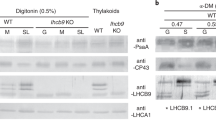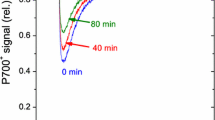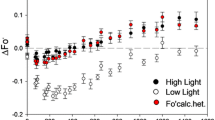Abstract
Susceptibility of a moss,Ceratodon purpureus (Hedw.) Brid., to photoinhibition and subsequent recovery of the photochemical efficiency of PSII was studied in the presence and absence of the chloroplast-encoded protein-synthesis inhibitor lincomycin.Ceratodon had a good capacity for repairing the damage to PSII centers induced by strong light. Tolerance against photoinhibition was associated with rapid turnover of the D1 protein, since blocking of D1 protein synthesis more than doubled the photoinhibition rate measured as the decline in the ratio of variable fluorescence to maximal fluorescence (Fv/Fmax). Under exposure to strong light in the absence of lincomycin a net loss of D1 protein occurred, indicating that the degradation of damaged D1 protein inCeratodon was rapid and independent of the resynthesis of the polypeptide. The result suggests that synthesis is the limiting factor in the turnover of D1 protein during photoinhibition of the mossCeratodon. The level of initial fluorescence (Fo) correlated with the production of inactive PSII centers depleted of D1 protein. The higher the Fo level, the more severe was the loss of D1 protein seen in the samples during photoinhibition. Restoration of Fv/Fmax at recovery light consisted of a fast and slow phase. The recovery of fluorescence yield in the presence of lincomycin, which was added at different times in the recovery, indicated that the chloroplast-encoded protein-synthesis-dependent repair of damaged PSII centers took place during the fast phase of recovery. Pulse-labelling experiments with [35S]methionine supported the conclusion drawn from fluorescence measurements, since the rate of D1 protein synthesis after photoinhibition exceeded that of the control plants during the first hours under recovery conditions.
Similar content being viewed by others
Abbreviations
- DTT:
-
dithiothreitol
- Fo, Fmax, and Fv :
-
initial, maximal and variable fluorescence, respectively
- LHCII:
-
light-harvesting chlorophylla/b-protein of PSII
- PFD:
-
photon flux density
References
Adir, N., Shochat, S., Ohad, I. (1990) Light-dependent D1 protein synthesis and translocation is regulated by reaction center II. J. Biol. Chem.265, 12563–12568
Arnon, D.I. (1949) Copper enzymes in isolated chloroplasts. Polyphenoloxidase inBeta vulgaris. Plant Physiol.24, 1–15
Aro, E.-M., Kettunen, R., Tyystjärvi, E. (1992) ATP and light regulate D1 protein modification and degradation. Role of D1* in photoinhibition. FEBS Lett.297, 29–33
Aro, E.-M., McCaffery, S., Anderson, J. (1993a) Photoinhibition and D1 protein degradation in peas acclimated to different growth irradiances. Plant Physiol.103, 835–843
Aro, E.-M., Virgin, I., Andersson, B. (1993b) Photoinhibition of Photosystem II. Inactivation, protein damage and turnover. Biochim. Biophys. Acta1143, 113–134
Bate, N.J., Rothstein, S.J., Thompson, J.E. (1991) Expression of nuclear and chloroplast photosynthesis-specific genes during leaf senescence. J. Exp. Bot.42, 801–811
Briantais, J.-M., Cornic, G., Hodges, M. (1988) The modification of chlorophyll fluorescence ofChlamydomonas reinhardtii by photoinhibition and chloramphenicol addition suggests a form of photosystem II less susceptible to degradation. FEBS Lett.236, 226–230
Butler, W.L. (1978) Energy distribution in the photochemical apparatus of photosynthesis. Annu. Rev. Plant Physiol.29, 345–378
Callahan, F.E., Ghirardi, M.L., Sopory, S.K., Mehta, A.M., Edelman, M., Mattoo, A.K. (1990) A novel metabolic form of the 32 kDa-D1 protein in the grana-localized reaction center of photosystem II. J. Biol. Chem.265, 15357–15360
Cleland, R.E., Ramage, R.T., Critchley, C. (1990) Photoinhibition causes loss of photochemical activity without degradation of D1 protein. Aust. J. Plant Physiol.17, 641–651
Demmig, B., Björkman, O. (1987) Comparison of the effect of excessive light on chlorophyll fluorescence (77 K) and photon yield of O2 evolution in leaves of higher plants. Planta171, 171–184
Demmig-Adams, B. (1990) Carotenoids and photoprotection in plants: A role for the carotenoid zeaxanthin. Biochim. Biophys. Acta1020, 1–24
Demmig-Adams, B., Adams III, W.W. (1992) Photoprotection and other responses of plants to high light stress. Annu. Rev. Plant Physiol. Plant Mol. Biol.43, 599–626
de Vitry, C., Diner, B.A., Popot, J.-L. (1991) Photosystem II particles fromChlamydomonas reinhardtii. Purification, molecular weight, small subunit composition, and protein phosphorylation. J. Biol. Chem.266, 16614–16621
Franklin, L.A., Levavasseur, G., Osmond, C.B., Henley, W.J., Ramus, J. (1992) Two components of onset and recovery during photoinhibition ofUlva rotundata. Planta186, 399–408
Giersch, C., Krause, G.H. (1991) A simple model relating photoinhibitory fluorescence quenching in chloroplasts to a population of altered Photosystem II reaction centers. Photosynth. Res.30, 115–121
Greer, D.H., Laing, W.A. (1992) Photoinhibition of photosynthesis in intact kiwifruit (Actinidia deliciosa) leaves: Changes in susceptibility to photoinhibition and recovery during the growth season. Planta186, 418–425
Greer, D.H., Berry, J.A., Björkman, O. (1986) Photoinhibition of photosynthesis in intact bean leaves: Role of light and temperature, and requirement for chloroplast-protein synthesis during recovery. Planta168, 253–260
Greer, D.H., Laing, W.A., Woolley, D.J. (1993) The effect of chloramphenicol on photoinhibition of photosynthesis and its recovery in intact kiwifruit (Actinidia deliciosa) leaves. Aust. J. Plant Physiol.20, 33–43
Guenther, J.E., Melis, A. (1990) The physiological significance of photosystem II heterogeneity in chloroplasts. Photosynth. Res.23, 105–109
Hanelt, D., Huppertz, K., Nultsch, W. (1992) Photoinhibition of photosynthesis and its recovery in red algae. Bot. Acta105, 278–284
Heifetz, P.B., Lers, A., Boynton, J.E., Gillham, N.W., Osmond, C.B. (1992) Photosynthetic consequences of specific chloroplast gene mutations affecting synthesis and function of the photosystem II D1 protein. In: Research in photosynthesis, vol. III, pp. 417–420, Murata, N., ed. Kluwer Acad. Publ., Dordrecht
Horton, P., Ruban, A.V. (1992) Regulation of photosystem II. Photosynth. Res.34, 375–385
Hurry, V.M., Huner, N.P.A. (1992) Effect of cold hardening on sensitivity of winter and spring wheat leaves to short-term photoinhibition and recovery of photosynthesis. Plant Physiol.100, 1283–1290
Huse, H., Nilsen, S. (1989) Recovery from photoinhibition: effect of light and inhibition of protein synthesis of 32-kD chloroplast protein. Photosynth. Res.21, 171–179
Jegerschöld, C., Virgin, I., Styring, S. (1990) Light-dependent degradation of the D1 protein in photosystem II is accelerated after inhibition of the water splitting reaction. Biochemistry29, 6179–6186
Kettunen, R., Tyystjärvi, E., Aro, E.-M. (1991) D1 protein degradation during photoinhibition of intact leaves. A modification of the D1 protein precedes degradation. FEBS Lett.290, 153–156
Kettunen, R., Lehtonen, E., Tyystjärvi, E., Aro, E.-M. (1992) Degradation products of the D1 protein are located in the non-appressed regions of the thylakoid membrane in vivo. In: Research in photosynthesis, vol. IV, pp. 309–316, Murata, N., ed. Kluwer Acad. Publ., Dordrecht
Klein, R.R., Mullet, J.E. (1987) Control of gene expression during higher plant chloroplast biogenesis. Protein synthesis and transcript levels of psbA, psaA-psaB, and rbcL in dark-grown and illuminated barley seedlings. J. Biol. Chem.262, 4341–4348
Krause, G.H. (1988) Photoinhibition of photosynthesis. An evaluation of damaging and protective mechanisms. Physiol. Plant.74, 566–574
Krause, G.H., Weis, E. (1991) Chlorophyll fluorescence and photosynthesis: The basics. Annu Rev. Plant Physiol. Plant Mol. Biol.42, 313–349
Kyle, D.J., Ohad, I., Arntzen, C.J. (1984) Membrane protein damage and repair: Selective loss of a quinone-protein function in chloroplast membranes. Proc. Natl. Acad. Sci. USA81, 4070–4074
Mans, R.J., Novelli, G.D. (1961) Measurement of the incorporation of radioactive amino acids into protein by a filter-paper disk method. Arch. Biochem. Biophys.94, 48–53
Mattoo, A.K., Hoffman-Falk, H., Marder, J.B., Edelman, M. (1984) Regulation of protein metabolism: Coupling of photosynthetic electron transport to in vivo degradation of the rapidly metabolized 32-kDa protein of the chloroplast membranes. Proc. Natl. Acad. Sci. USA81, 1380–1384
Nedbal, L., Samson, G., Whitmarsh, J. (1992) Redox state of one-electron component controls the rate of photoinhibition of photosystem II. Proc. Natl. Acad. Sci. USA89, 7929–7933
Ohad, I., Kyle, D.J., Hirschberg, J. (1985) Light-dependent degradation of the QB-protein in isolated pea thylakoids. EMBO J.4, 1655–1659
Ohad, I., Koike, H., Shochat, S., Inoue, Y. (1988) Changes in the properties of reaction center II during the initial stages of photoinhibition as revealed by thermoluminescence measurements. Biochim. Biophys. Acta933, 288–298
Okada, K., Satoh, K., Katoh, S. (1991) Chloramphenicol is an inhibitor of photosynthesis. FEBS Lett.295, 155–158
Öquist, G., Anderson, J.M., McCaffery, S., Chow, W.S. (1992) Mechanistic differences in photoinhibition of sun and shade plants. Planta188, 422–431
Quick, W.P., Stitt, M. (1989) An examination of factors contributing to non-photochemical quenching of chlorophyll fluorescence in barley leaves. Biochim. Biophys. Acta977, 287–296
Prasil, O., Adir, N., Ohad, I. (1992a) Dynamics of photosystem II: Mechanism of photoinhibition and recovery processes. In: Topics in photosynthesis, vol. 11., pp. 293–348, Barber, J., ed. Elsevier, Amsterdam
Prasil, O., Zer, H., Godde, D., Ohad, I. (1992b) Role of the PSII acceptor site in the light induced degradation of D1. In: Research in photosynthesis, vol. IV, pp. 501–504, Murata, N., ed. Kluwer Acad. Publ., Dordrecht
Rintamäki, E., Salo, R., Aro, E.-M. (1992) Turnover of D1 protein during photoinhibition and recovery in a mossCeratodon purpureus. In: Research in photosynthesis, vol. IV, pp. 431–434, Murata, N., ed. Kluwer Acad. Publ., Dordrecht
Salter, H., Virgin, I., Hagman, Å., Andersson, B. (1992) On the molecular mechanism of light-induced D1 protein degradation in Photosystem II core particles. Biochemistry31, 3990–3998
Schnettger, B., Santore, U.J., Critchley, C., Leitsch, J., Krause, G.H. (1992) Light-induced turnover of the D1 protein of the photosystem II reaction centre and photoinhibition in vivo. In: Research in photosynthesis, vol. IV, pp. 423–426, Murata, N., ed. Kluwer Acad. Publ., Dordrecht
Schuster, G., Timberg, R., Ohad, I. (1988) Turnover of thylakoid photosystem II proteins during photoinhibition ofChlamydomonas reinhardtii. Eur. J. Biochem.177, 403–410
Syme, A.J., Bolhar-Nordenkampf, H.R., Critchley, C. (1992) Light-induced D1 protein degradation and photosynthesis in sun and shade leaves. In: Research in photosynthesis, vol. IV, pp. 337–340, Murata, N., ed. Kluwer Acad. Publ., Dordrecht
Taniguchi, M., Kuroda, H., Satoh, K. (1993) ATP-dependent protein synthesis in isolated pea chloroplasts. Evidence for accumulation of a translation intermediate of the D1 protein. FEBS Lett.317, 57–61
Tyystjärvi, E. (1933) Photoinhibition — Struggle between damage and repair of photosystem II. PhD Thesis, University of Turku, Turku
Tyystjärvi, E., Ali-Yrkkö, K., Kettunen, R., Aro, E.-M. (1992) Slow degradation of the D1 protein is related to the susceptibility of low-light-grown pumpkin plants to photoinhibition. Plant Physiol100, 1310–1317
Valanne, N., Aro, E.-M., Repo, E. (1978) Changes in photosynthetic capacity and activity of RuBPC-ase and glycolate oxidase during the early growth of moss protonemata in continuous and rhythmic light. Z. Pflanzenphysiol.88, 123–131
Vass, I., Styring, S., Hundal, T., Koivuniemi, A., Aro, E.-M., Andersson, B. (1992) Reversible and irreversible intermediates during photoinhibition of photosystem II: Stable reduced QA species promote chlorophyll triplet formation. Proc. Natl. Acad. Sci. USA89, 1408–1412
Yamamoto, H.Y., Kamite, T. (1972) The effects of dithiothreitol on violaxanthin de-epoxidation and absorbance changes in the 500 nm region. Biochim. Biophys. Acta267, 538–543
Author information
Authors and Affiliations
Rights and permissions
About this article
Cite this article
Rintamäki, E., Salo, R. & Aro, EM. Rapid turnover of the D1 reaction-center protein of photosystem II as a protection mechanism against photoinhibition in a moss,Ceratodon purpureus (Hedw.) Brid.. Planta 193, 520–529 (1994). https://doi.org/10.1007/BF02411557
Received:
Accepted:
Issue Date:
DOI: https://doi.org/10.1007/BF02411557




